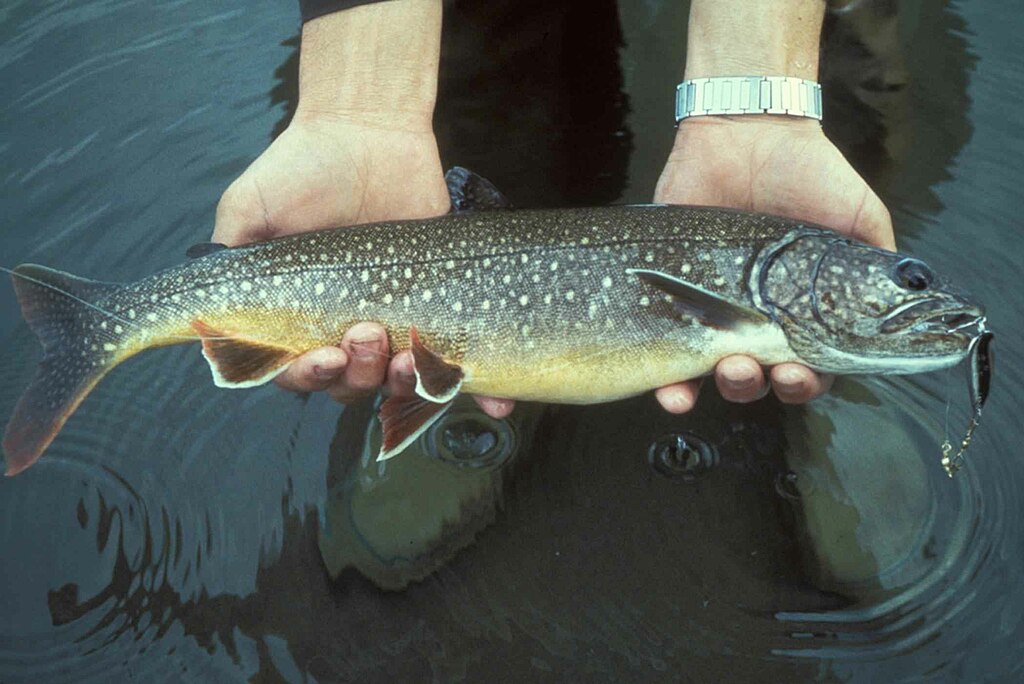
Lake Trout
Scientific Name: Salvelinus namaycush
Also known as: Mackinaw, Togue, Grey Trout
General Description
The Lake Trout is a large, cold-water species known for its powerful fighting ability and impressive size, often reaching up to 30 pounds or more. With a body that can grow up to 36 inches long, this species is easily recognizable by its slender form and dark, olive-brown to greyish color, with lighter spots scattered across its back and sides. The belly is often pale and slightly speckled, and its tail fin is deeply forked, a characteristic feature of the species.
Lake Trout are a prized catch for anglers due to their size and the challenge they present. They are often found in deep, cold lakes and prefer water temperatures between 45°F and 55°F. They are opportunistic predators, feeding on smaller fish like minnows, yellow perch, and other fish species, which makes them particularly skilled hunters in their native habitats. They are highly migratory, moving between deep, cooler waters during the warmer months and shallow areas for spawning in the colder months. Due to their predatory nature, Lake Trout are often difficult to catch and require specialized gear and techniques.
Their strong, athletic fight and sizable growth make Lake Trout one of the most sought-after fish species for serious anglers looking for a rewarding challenge.
Where to Find Them
Lake Trout are native to cold, clear lakes in North America, particularly in the northern United States and Canada. They thrive in large, deep lakes where the water remains cool year-round. Some of the most famous lakes for Lake Trout include the Great Lakes, especially Lake Superior, as well as Lake Ontario and Lake Michigan. In Canada, they are found in the deep waters of lakes such as Lake Nipigon, Great Slave Lake, and the many lakes in the northern regions of Ontario and Quebec.
While Lake Trout are most commonly found in large, deep lakes, they also inhabit some reservoirs in the western U.S., particularly in states like Colorado, Montana, and Wyoming, where they have been stocked for recreational fishing. In these lakes, they tend to stay in the cooler, deeper parts during the summer months, retreating to depths of 40 to 100 feet to avoid warmer surface waters. During the spawning season in late fall and early winter, they migrate to shallower areas, often near rocky shorelines or river mouths.
Lake Trout are also present in some alpine lakes in the U.S. and Canada, particularly at higher elevations where the water remains cold year-round. These fish are typically found in lakes that have low levels of pollution, as they are very sensitive to water quality and prefer pristine environments.
Best Baits
Live Bait Options
- Small minnows (shiners, alewives)
- Yellow perch
- Smelt
- Crayfish
Artificial Bait Options
- Jigs (tipped with minnows or soft plastics)
- Spoon lures (silver, gold, and brightly colored)
- Soft plastics (minnow imitations)
- Crankbaits (deep-diving models)
- Swimbaits (larger sizes imitating fish prey)
Best Fishing Methods
Fishing for Lake Trout requires specialized equipment and techniques due to their deep-water habits and strong fighting ability. One of the most effective methods for targeting Lake Trout is trolling with deep-diving crankbaits or spoons. By slowly dragging these lures at depths of 40 to 100 feet, anglers can mimic the movement of the fish that Lake Trout prey on. Trolling is particularly effective in larger lakes where the fish can be spread out over vast areas. It’s important to use downriggers or weighted lines to reach the right depth, as these fish typically stay well below the surface.
Ice fishing is another popular method for catching Lake Trout, especially in colder months when they move closer to the lakebed for spawning. Fishing through the ice in deep lakes with jigs tipped with minnows or soft plastics can yield successful results. The deep, clear waters make sonar devices especially useful in locating schools of Lake Trout.
In deeper lakes, anglers may also vertical jig or drift fish near submerged structures or drop-offs. This method involves dropping a jig to the lake’s bottom and then lifting it steadily to mimic the movement of injured prey. In clear lakes, using live bait, like minnows or yellow perch, can also attract these predatory fish.
Lake Trout are typically most active during early morning or late evening when the water is cooler. During the warmer months, they seek refuge in deeper, cooler waters, so fishing during the early summer or late fall is ideal.
Summary
Fishing for Lake Trout offers an exciting challenge for those looking to land a big, powerful fish. These majestic fish can grow to impressive sizes and are prized for their fierce fighting ability. Known for their preference for cold, deep water, Lake Trout are found in large, clear lakes throughout North America, including the Great Lakes and other northern waters. They are typically caught by trolling deep-diving lures, spoons, or using live bait like minnows and perch.
Lake Trout are particularly active in cooler months, often retreating to deeper waters in the summer heat and returning to shallow, rocky shorelines for spawning. Specialized equipment like downriggers, sonar, and ice-fishing gear are essential for targeting them effectively. Because of their migratory nature, anglers need to understand seasonal movements and be prepared to fish at different depths throughout the year.
Their beautiful, silvery appearance and challenging nature make them one of the most sought-after freshwater fish species. Whether you’re fishing on the ice in winter or trolling in the summer, Lake Trout offer an unforgettable fishing experience for those who seek them out in their pristine, cold-water habitats.


